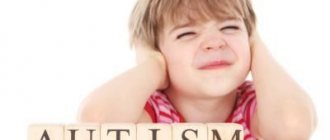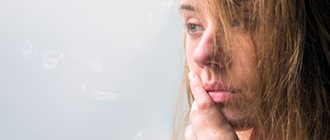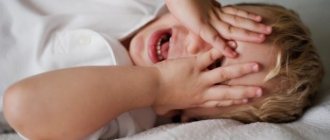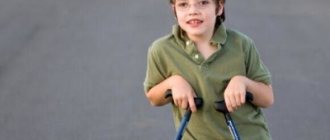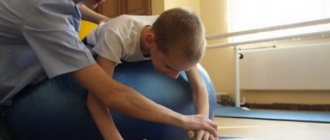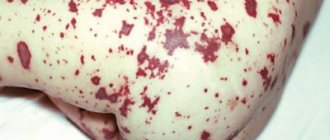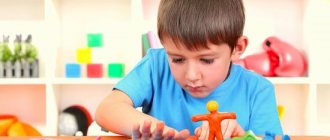Autism - what kind of disease is it? Causes of autism, symptoms and early signs
Autism in children is a special personality disorder, which, although characterized by a violation of social behavior and adaptation to environmental conditions, is not a disease.
The syndrome develops in the first years of a child’s life, when there is an absence or inadequate reaction to auditory or visual stimuli, strange fears, and repetitive behavior. If similar symptoms are observed in a teenager, this diagnosis is doubtful.
The level of intellectual development in this disease can be very different: from profound mental retardation to giftedness in certain areas of knowledge and art; In some cases, children with autism have no speech, and there are deviations in the development of motor skills, attention, perception, emotional and other areas of the psyche. More than 80% of children with autism are disabled.
Causes of autism
Most often, children with RDA are physically absolutely healthy; they do not show any visible external defects. In mothers, pregnancy proceeds without any special features. In sick babies, the structure of the brain is practically no different from the norm. Many even notice the special attractiveness of the facial part of an autistic child.
However, in some cases, other signs of the disease still appear:
- maternal infection with rubella during pregnancy;
- chromosomal abnormalities;
- tuberous sclerosis;
- cerebral palsy;
- violation of fat metabolism - obese women have a high risk of giving birth to a child with congenital autism.
All of the above conditions have a negative impact on the child’s brain and can lead to the development of autism. According to research, genetic predisposition plays a role: if there is an autistic person in the family, the risk of developing the disease increases. However, reliable reasons have not yet been identified.
Spiritual reasons
Psychology has its own views on the causes of such a disease. Spiritual and psychological factors play a significant role in the development of autism. The psychosomatics of the disease indicates that the physiological manifestations of such a disease are closely related to the psychological ones. For example, a child loses speech skills due to an unwillingness to communicate with others.
The psychological reasons that influenced the acquisition of the disease in this case are:
- problems in relationships with mother in early childhood;
- insufficient attention to the baby from parents;
- suffered severe emotional stress;
- complete neglect of the child by the mother, early weaning;
- psychological trauma in a child;
- distorted perception of the surrounding world due to insufficient knowledge of it.
Such children often develop not congenital, but acquired autism.
Symptoms of autism in a child
In some children, symptoms of autism can be detected as early as infancy. Autism most often appears by age three. Signs of autism may vary depending on the child's developmental level and age (see photo).
Behavioral characteristics used to describe autism syndrome:
The development of non-speech and speech communication is impaired. Characteristic:
- Speech is normal, but the child cannot talk with others;
- The speech is abnormal in content and form, that is, the child repeats phrases heard somewhere that do not apply to the given situation;
- Lack of facial expressions and gestures. Speech may also be absent;
- The child never smiles at the interlocutor, does not look him in the eyes;
- Speech is phonetically abnormal (problems with intonation, rhythm, monotony of speech).
The development of imagination is impaired, which leads to a limited range of interests. Characteristic:
- Preference is given to solitude, playing with oneself;
- Lack of imagination and interest in imaginary events;
- gravitates toward a certain object and experiences an obsessive desire to constantly hold it in his hands;
- Unnatural, nervous, aloof behavior;
- An autistic child exhibits tantrums when the environment changes;
- Experiences a requirement to repeat the same actions exactly;
- Concentrates his attention on one thing.
The development of social skills is impaired. Characteristic:
- Ignoring the feelings and existence of other people (even parents);
- They don’t share their problems with loved ones because they don’t see the need for it;
- Children do not want to communicate and make friends with their peers;
- They never imitate the facial expressions or gestures of other people or repeat these actions unconsciously, without connecting them in any way with the situation.
People with autism are characterized by uneven development, which gives them the opportunity to be talented in some narrow area (music, mathematics). Autism is characterized by impaired development of social, thinking, and speech skills.
Autism
4938 23 June
IMPORTANT!
The information in this section cannot be used for self-diagnosis and self-treatment. In case of pain or other exacerbation of the disease, diagnostic tests should be prescribed only by the attending physician. To make a diagnosis and properly prescribe treatment, you should contact your doctor. Definition
Autism, or more precisely, autism spectrum disorders (ASD), is a group of mental disorders that are characterized by impairments in social interaction and communication - the process of communicating and transmitting information to other people. In autism, restricted, stereotypical, repetitive behavior is observed. In different patients, the disorders are expressed to varying degrees, and they may or may not be accompanied by disturbances in speech and intellectual development.
The first signs of the disease are observed already in infancy or early childhood, anomalies in social functioning and behavioral characteristics persist throughout life.
Causes of autism
The causes of autism spectrum disorder are not fully understood, but genetic factors are believed to play a major role. It is known that the risk of having a child with ASD increases with the age of the parents.
There is a possible connection between the occurrence of ASD in a child and features of the course of pregnancy: prematurity of the fetus, the use of valproic acid by the mother during pregnancy to treat epilepsy, manic-depressive psychosis, migraine, as well as gestational diabetes in the mother (diabetes mellitus that develops during pregnancy). It is unlikely that any of these factors is critical in the development of ASD, but can be realized in interaction with genetic predisposition.
Autism is more often diagnosed in boys, with a gender ratio of approximately 3:1.
Since the mid-1990s, there have been concerns about the possible link between vaccination and ASD. Current epidemiological data indicate that there is no such association. Moreover, there is no evidence of an association between vaccine use and the risk of ASD, even when vaccinating children at risk - siblings of children with ASD. It has been proven that the preservative thiomersal and aluminum adjuvant contained in inactivated vaccines do not increase the likelihood of ASD in vaccinated children. According to many international studies, changes in the vaccination schedule, withdrawal of any vaccines and their components did not affect the incidence of ASD.
Classification of the disease
Depending on the number of symptoms and their severity, there are three main types of ASD: childhood autism, atypical autism and Asperger's syndrome.
Asperger's syndrome is the mildest form of ASD - intelligence is not affected, changes can be regarded as personality traits and do not interfere with a person's professional development and social adaptation.
There is a division of ASD depending on the presence or absence of intellectual disabilities and the person's ability to use spoken or written language as a means of expressing needs or desires.
Symptoms of Autism
The main manifestations of ASD are impairments in social interaction, communication (anomalies in communication) and limited, stereotypical, repetitive behavior. In addition, patients often have other nonspecific problems: various phobias (fears), sleep and eating disorders, aggression and auto-aggression (aggression directed at oneself). Contrary to popular belief, autism spectrum disorders are not associated with high levels of intelligence in most cases, although some patients may have extraordinary abilities in some area of knowledge.
Let us dwell in more detail on the description of the main manifestations of the disease.
Disorders of social interaction and social communication. Parents pay attention to the fact that the child rarely uses eye contact, gestures, facial expressions and posture to regulate social interaction; he has reduced interest in interacting with peers and adults. The child may not speak or begin to speak with a strong delay, and if he does speak, he does not start a conversation, does not ask questions, communicates exclusively on topics that interest him; may repeat the same words and phrases over and over again. The baby has no desire to be held; he does not always distinguish his parents from other people. Such children do not look at the interlocutor, may not respond to speech addressed to them, to requests, may not respond to names, they do not or are reluctant to enter into dialogue, and do not smile in response.
Often, unusual behavior can be observed in a child with autism, for example, violation of bodily boundaries, lack of embarrassment or excessive anxiety when interacting with new people, monotonous scenarios in communication.
After the age of 7 years, some children with ASD remain speechless or have a minimal vocabulary. Other children, when starting to communicate, are unable to build long-term friendships and respect social rules. The problem for many older children and adults with autism is the inability to understand and feel the state of other people, their mood.
People with ASD are characterized by naivety and simple-mindedness, they do not understand irony and humor well, and have difficulty maintaining a dialogue and understanding the rules of behavior.
Many patients with ASD retain excessive or, conversely, absent gesticulation, unstable or excessive eye contact.
Stereotypical, repetitive behavior, limited interests and hobbies. With the exception of Asperger's syndrome, most patients have a decrease in intelligence of varying degrees of severity. Children with ASD are characterized by unique play activities; for example, a child may use toys in an unusual way: throw them around, lick them, or perform other monotonous manipulations. Already in early childhood, selective interests often manifest themselves - for example, this can be the study of moving objects, a passion for narrow topics (interest in the alphabet, numbers, names and individual characteristics of objects). Such children experience significant difficulties when it is necessary to switch attention.
With age, the set of symptoms may change in content and severity. Many older children and adults are characterized by inflexibility of thinking, manifested by a lack of response to changing environmental conditions, difficulty in assimilation and use of new information, practical skills, and an excessive tendency to detail.
Diagnosis of autism
When collecting complaints and examining the patient, the doctor pays attention to the patient’s behavioral characteristics and assesses the current psychiatric status and level of development.
To clarify the diagnosis and increase the accuracy of clinical diagnosis, additional standardized methods related to the “gold standard” are used: ADOS-II and ADI-R.
ADOS-II is a test administered by a child or adult psychiatrist or clinical psychologist. It consists of observing the patient performing certain tasks in a playful manner. Depending on age, ability to speak and play, the doctor chooses one or another module - a type of testing. Modules vary in the complexity of the proposed games, activities and the presence of speech tasks. Module 1 is used for children speaking in separate words. 2nd - for children using sentences of several words. 3rd – for children who communicate freely. 4th – for freely communicating teenagers and adults. Using a certain set of toys and objects, the specialist creates various play situations. He observes the work being done, evaluating facial expressions, words, and methods of solving the proposed tasks. Completing the tasks lasts about an hour, after which the specialist processes the test results and draws up a conclusion. Usually the test is recorded on video, which helps make a more accurate diagnosis and provides an opportunity for other specialists to assess the child’s condition.
ADOS-II is not the only criterion for diagnosis. The ADI-R screening may be used as an additional test to collect more data.
ADI-R - an interview containing about 100 questions, conducted by a psychologist or psychiatrist; but not with the patient, but with his parents or other close people. Questions aimed at assessing:
- quality of social contact;
- quality of communication and speech characteristics,
- patterns of behavior (repetitive, restricted or stereotyped actions).
To clarify the direct cause of ASD, genetic testing may be recommended for children and adolescents with an already established diagnosis.
It is compiled according to an individual plan with the involvement of geneticists or other specialists. Instrumental examination methods are of secondary importance and are not leading in the diagnosis of ASD. Electroencephalography (EEG), computed tomography (CT) of the brain, and magnetic resonance imaging (MRI) of the brain are not recommended for all children and adolescents with ASD or suspected ASD. On the one hand, this is due to the fact that difficulties may arise during the examination due to ASD-specific impairments in the patient’s communication and behavioral skills. On the other hand, these studies cannot confirm or refute the diagnosis of autism spectrum disorder, but can be indicated for making a diagnosis and determining treatment tactics if the presence of other disorders is suspected, for example, epilepsy or a brain tumor.
Which doctors should I contact?
Autism may be suspected. Confirms the diagnosis, prescribes therapy and observes patients for children, and then for adults, a psychiatrist, neurologist, and psychologist.
Treatment of autism
There is currently no direct treatment for ASD. Prescribed medications, for example, from the group of antidepressants, can help solve various nonspecific problems - sleep and eating disorders, increased irritability, attacks of aggression directed at oneself or others. The main treatment methods for ASD are predominantly non-pharmacological. They include educational and psychological assistance aimed at socializing a person with ASD - the earlier assistance is started, the better the child’s development prognosis.
There are many methods of treating and helping patients with ASD that have no proven effectiveness: gluten-free and casein-free diets, brain micropolarization, the Tomatis method, bioacoustic correction, art therapy, as well as hippotherapy, dolphin therapy and many others. If parents insist on using these methods, it is important to understand that they should not be used in place of a primary treatment program.
Nootropic and peptide drugs are often used in the treatment of patients with ASD. There is currently no convincing evidence of their ability to influence the development of cognitive and language skills. At the same time, they can increase motor activity, cause disinhibition and sleep disorders.
Complications of the disease
With autism, various damages are possible that the patient inflicts on himself and others.
Due to impaired cognitive functions, speech, and difficulties in interacting with others, patients with ASD, with the exception of patients with Asperger syndrome, in most cases cannot live independently, study and work.
Due to the high pain threshold and behavioral characteristics of those suffering from ASD, diagnosis and treatment of other diseases is difficult.
Prevention of autism
There are currently no specific measures to prevent ASD. However, early diagnosis is a necessary condition for organizing early comprehensive care for the child, which can improve the prognosis.
Sources:
- Clinical recommendations. Autism spectrum disorders. Developer of the clinical recommendation Association of Psychiatrists and Psychologists for Evidence-Based Practice Approved by the Scientific and Practical Council of the Ministry of Health of the Russian Federation, 2021. – p. 52.
- Bozhkova E.D., Balandina O.V., Konovalov A.A. Autism spectrum disorders: current state of the problem (review). Modern technologies in medicine. T. 12, No. 2, 2021. pp. 111-120.
IMPORTANT!
The information in this section cannot be used for self-diagnosis and self-treatment. In case of pain or other exacerbation of the disease, diagnostic tests should be prescribed only by the attending physician. To make a diagnosis and properly prescribe treatment, you should contact your doctor.
Autism in a child over 11 years old
Simple communication skills have been mastered, but the child prefers to spend time in a deserted room. Other signs are also noted:
- interest is directed only to one area, a toy, a cartoon, a program;
- attention deficit;
- aimless complex movements;
- compliance with one’s own, often ridiculous from the outside, rules;
- strange fears also occur;
- hyperactivity;
- the need for a uniform arrangement of furniture and things in the house - if it is moved, the child may have a hysteria or panic attack;
- the child must follow a certain sequence when dressing, waking up, and going to bed;
- self-directed aggression.
Teaching children with autism is difficult, but this does not mean that all autistic people have a low IQ - it is difficult for them to quickly change their activity and focus their attention equally on several objects. Parenting requires enormous effort on the part of parents: after all, if a child has learned to go to the potty or change clothes at home, this does not mean that he will be able to do this at a party or in kindergarten.
Symptoms of the disease between the ages of 2 and 11 years
Children with autism at this age still experience symptoms that were relevant for the previous period. The child does not respond to his own name, does not look him in the eye, likes to be alone, and has no interest in other children. In addition, other characteristic symptoms of the disease are noted:
- Perhaps, again, repetition of the same type of actions (peculiar rituals), when changing his usual environment, he becomes very anxious.
- The child knows only a few words and may not speak at all.
- The child may constantly repeat the same word; he does not maintain a conversation.
- For the most part, children with autism struggle to acquire skills that are new to them; at school age they lack the ability to read or write.
Some children develop an interest in a certain type of activity, for example, mathematics, music, drawing, etc.
Symptoms
Childhood autism inevitably exhibits some symptoms. You should see a doctor if your child:
- Avoids eye contact;
- Reacts too much to small stimuli such as noise or light;
- Not talking;
- Often hysterical;
- Too active or, conversely, too passive;
- Arranges objects in a line many times;
- Doesn't play with other children;
- Reacts negatively to tactility.
At the same time, the symptoms must be considered together, that is, the child’s activity itself in no way indicates his mental disorders, but if you notice the presence of several points, this is a reason to be wary. It is important to remember that only a properly qualified specialist can diagnose autism, what kind of disease it is, the symptoms and causes of the disease.
There are often three groups of the most important signs that a child has a disease, which are presented below.
Signs of early childhood autism under 2 years of age
In most cases, manifestations of the disease are observed in children during the first year of their life. There may be characteristic differences in the behavior of a sick child from the behavior of peers. The following symptoms are also noted:
- The child rarely smiles;
- There is no attachment to the mother. So, the child does not cry like other children when she goes somewhere, he does not smile at her and does not reach out for her arms;
- A child with autism does not look at the parents’ face, into their eyes;
- The child may have an inadequate response to stimuli that are insignificant for others (light, muffled sounds, etc.), in addition, he may experience fear because of them.
- The child is noted to be aggressive towards other children, he does not strive to communicate with them and to play together;
- A sick child gives preference to only one toy (or a separate part of it) in play; there is no interest in other toys;
- There is a delay in speech development. So, by 12 months the child does not babble, does not use the simplest words by the age of 16 months, and by the age of 24 months does not reproduce simple phrases.
Meanwhile, it is important to note that such symptoms are not at all exclusive indicators of the relevance of autism, although they require some concern. Therefore, the child’s avoidance of society, his silence, self-absorption - all these manifestations must be discussed with the pediatrician.
Autistic disorders: types
There are several types of autistic disorders, which differ in severity and form of manifestation, and therefore require different methods of correction.
Asperger's syndrome
This is a mild form of the disease. The first symptoms begin to appear at about 7 years of age. Features of a child who has been diagnosed with this form of the disease:
- has a fairly high level of intelligence;
- speaks clearly, but loudly, has problems with intonation;
- self-centered, refuses to compromise;
- takes uncharacteristic postures and walks awkwardly due to lack of coordination;
- gets fixated on one thing.
Provided that favorable conditions for development and upbringing are created, a child with Asperger syndrome will be able to live a normal life in the future. Along with his peers, he is able to graduate from school and university, start a family, and get a job.
Rett syndrome
This is a consequence of abnormalities in the female chromosome, so the disease can only appear in girls. Boys who receive such a chromosome die during pregnancy. This syndrome is considered a severe form of the disease and occurs approximately very rarely, 1 time in 10 thousand children. The manifestation of pathology is accompanied by the following clinical symptoms:
- After birth, the child develops fully within a year, after which obvious signs of mental retardation begin to appear sharply.
- The rate of head growth after a year is significantly reduced, and impaired coordination of movements develops.
- Complete lack of speech.
- The child withdraws into himself, completely isolating himself from the outside world.
- Skills acquired before the age of one are lost.
- The child often makes meaningless repeated movements with his hands, as if washing himself.
This is a severe form of the disease, which is practically impossible to correct, so when diagnosed, in most cases the prognosis is unfavorable.
IQ level in autism
Most children with autism have mild or moderate mental retardation. It is associated with brain defects and learning difficulties. If the disease is combined with microcephaly, epilepsy and chromosomal abnormalities, then the level of intelligence corresponds to severe mental retardation. With mild forms of the disease and dynamic development of speech, intelligence can be normal or even above average.
The main feature of autism is selective intelligence. That is, children can be strong in mathematics, music, and drawing, but at the same time be far behind their peers in other respects. The phenomenon when an autistic person is extremely gifted in some area is called savantism. Savants can play a melody after hearing it just once. Or paint a picture seen once, accurate to halftones. Or keep columns of numbers in your head, performing complex computational operations without additional means.
General information about the disorder
Over the past 25 years, the frequency of detection of pathology has increased significantly. However, the reasons for this increase are still unknown. It is assumed that the increase in the percentage of sick children is not due to the spread of the disorder, but to a change in diagnostic criteria.
Statistics on the prevalence of this disorder vary significantly. This is due to the fact that different countries use different approaches to diagnosing pathology and its classification. According to generalized data, about 0.1-0.6% of children suffer from autism. At the same time, the disease, taking into account autism spectrum disorders, affects 1.1-2% of children.
The disorder manifests itself at an early age. It is noteworthy that the frequency of detection of pathology depends on gender. Girls suffer from autism three to five times less often than boys. Some scientists believe that this is due to different genetics of the pathology. Others are of the opinion that the reason lies in the better development of communication abilities in girls, due to which mild forms of autism may remain invisible in them. Source: Gender Differences in Childhood Autism. Klinkov V.N., Soiko V.V. Tauride Journal of Psychiatry, 2015. p. 9-13.
Severity
There are several degrees of severity, which make it even more clear what autism is:
| 1st degree | Children can communicate, but in unusual surroundings they are easily lost. Movements are awkward and slow; the child does not gesture, his speech is amicable. Sometimes such children are diagnosed with mental retardation. |
| 2nd degree | Children do not appear withdrawn or aloof. They talk a lot, but do not address anyone. They especially love to talk about their area of interest, which they have studied thoroughly. |
| 3rd degree | In a familiar environment, the child behaves normally, but when visiting new places he has an attack of panic or self-injury. Such a patient confuses pronouns and answers with useless cliches. |
| 4th degree | Children do not respond to treatment, do not make eye contact, and practically do not speak. If they are comfortable, they sit for hours, looking ahead, discomfort manifests itself in screaming and crying. |
Types of autism
Doctors use several types of distributions in practice. Most often, experts use Nikolskaya’s classification, which allows us to distinguish four forms of autism in children depending on the severity of symptoms. Accordingly, further therapeutic actions and prognosis depend on the established type of disease.
- First form . The most severe type of disorder with the most pronounced manifestations. It is characterized by an almost complete absence of the need to contact others, as well as a person’s inability to take care of himself. Such children are always detached and constantly use simple, repetitive movements. The main goal of therapy is to establish contact, engage in interaction, and develop self-care skills.
- Second form . In a familiar environment, autistic people are open-minded and show abilities for simple everyday skills. Speech disorders manifest themselves in cliched repetition of the same phrases. The main pathology is the rejection of reality. They do not want to learn or change, and they express their protest through aggression or negativism. Treatment is aimed at developing contacts with loved ones, developing different behavior scenarios to adapt to the world around us.
- Third form . The child strives for learning and new achievements, but at the same time is afraid to take risks and does not know how to find compromises. Against the background of good general encyclopedic knowledge, there is a weak understanding of the real world and an inability to conduct dialogue. The key therapeutic goal is to teach communication and develop behavioral skills in society.
- Fourth form . The easiest, best amenable to correction. A timid and very vulnerable person can behave adequately in society, but at the same time does not know how to concentrate, work according to instructions, or adhere to regulations. Therapy is aimed at developing innate abilities and social skills.
Diagnosis of autism
External clinical signs of autism in a child of the first year of life are practically absent, and only experienced parents with more than 1 child in the family manage to notice any developmental abnormalities with which they consult a doctor.
If there are already cases of autism in the family or lineage, then it is extremely important to carefully monitor the child and promptly seek medical help if necessary. The sooner a child is diagnosed, the easier it will be for him to adapt to the world and society around him.
The main methods for diagnosing autism in children are:
- examination of the child by an otolaryngologist and a hearing test - this is necessary to exclude delayed speech development due to hearing loss;
- EEG – carried out to detect epilepsy, since sometimes autism can manifest itself as epileptic seizures;
- Ultrasound of the brain - allows you to identify or exclude damage and abnormalities in the structure of the brain that can provoke symptoms of the disease;
- conducting tests with special questionnaires.
Parents themselves must correctly assess changes in the behavior of a child who may have autism.
Hereditary predisposition
Content:
- Hereditary predisposition
- autism gene
- Viruses
- Vaccine
- Gluten as a provocateur of developmental disabilities
- Spiritual reasons
- Psychological state and lifestyle of the mother
- Summing up
Genetically altered genes are one of the main reasons why this disease occurs and develops. Autism is hereditary, which means that autistic children who suffer from this disease were initially susceptible to it at the genetic level. Heredity is the reason why several children in one family suffer from this disease. And scientific research states that the risk of developing early childhood autism among sisters and brothers increases three to eight times.
There are many genetic problems associated with autism. They are directly connected to proteins, proteins, neurons and mitochondria. It should be noted that a mitochondrial defect is a genetic failure that occurs most often in autistic people. At the same time, a genetic predisposition to protein disorders and deviations in neural interaction, occurring at the cellular level, is clearly visible. Such changes often lead to the destruction of cell membranes and provoke the production of energy in the mitochondria.
Treatment of autism
The answer to the main question: is autism treatable? -No. There is no cure for this disease. There is no pill that, after drinking, will help an autistic child come out of his “shell” and become socialized. The only way to adapt an autistic person to life in society is through persistent daily practice and the creation of a favorable environment. This is a lot of work by parents and teachers, which almost always bears fruit.
Principles of raising an autistic child:
- Create a favorable environment for the child’s life, development and learning. A frightening environment and an unstable daily routine slow down an autistic person’s skills and force them to “withdraw” even deeper.
- Understand that autism is a way of being. A child with this condition sees, hears, thinks and feels differently from most people.
- Involve a psychologist, psychiatrist, speech therapist and other specialists in working with the child if necessary.
At the present stage, help for sick children can only be provided by a correctional program drawn up by a competent specialist - a sequence of actions that are carried out not to cure autism (it cannot be treated), but with the goal of maximizing the child’s adaptation to environmental conditions.
To implement this program, the help of parents is very important, because for the baby the whole world is incomprehensible and hostile.
Correction is carried out in special rehabilitation centers (for example, Our Sunny World or Childhood). The correction program depends on the form and severity of the disease. It includes:
- drug treatment;
- gluten-free diet;
- hippotherapy;
- behavioral therapy;
- music therapy;
- play therapy;
- exercise therapy;
- dolphin therapy;
- massage.
Classes of different types of therapy can be conducted in different centers. Thus, hippotherapy is usually carried out in a specially equipped arena, music treatment is carried out in special rooms. Physical therapy and massage are usually carried out in the same clinic.
What to do?
Yes, autism is a child development disorder that lasts throughout life. But thanks to timely diagnosis and early correctional assistance, much can be achieved: adapt the child to life in society; teach him to cope with his own fears; control emotions.
- The most important thing is not to disguise the diagnosis as supposedly “more harmonious” and “socially acceptable.” Do not run away from the problem and do not focus all your attention on the negative aspects of the diagnosis, such as disability, misunderstanding of others, conflicts in the family, etc. An exaggerated idea of a child as a genius is just as harmful as a depressed state from his failure.
- It is necessary without hesitation to abandon tormenting illusions and plans for life built in advance. Accept the child for who he really is. Act based on the child’s interests, creating an atmosphere of love and goodwill around him, organizing his world until he learns to do it on his own.
Remember that a child with autism cannot survive without your support.
Teaching an autistic child
An autistic child, as a rule, cannot study in a regular school. More often, homeschooling is done by parents or a visiting specialist. Special schools have been opened in large cities. Training there is carried out using special methods.
The most common training programs:
- “Time on the floor”: the technique suggests treatment and teaching communication skills to be carried out in a playful way (a parent or teacher plays with the child on the floor for several hours).
- “Applied Behavior Analysis”: step-by-step training under the guidance of a psychologist from simple skills to the formation of spoken language.
- The “More Than Words” program method teaches parents to understand the nonverbal way of communicating with a child using gestures, facial expressions, his gaze, etc. The psychologist (or parents) help the child develop new methods for communicating with other people that are more understandable to them.
- Card exchange teaching method: used for severe autism and when the child has no speech. During the learning process, the child is helped to remember the meaning of various cards and use them for communication. This allows the child to take initiative and facilitates communication.
- “Social stories” are original fairy tales written by teachers or parents. They should describe situations that cause the child’s fears and anxiety, and the thoughts and emotions of the characters in the stories suggest the child’s desired behavior in such a situation.
- The TEASSN program: the methodology recommends an individual approach to each child, taking into account his characteristics and learning goals. This technique can be combined with other teaching technologies.
A strict daily routine, constant and not always successful activities with a child suffering from autism leave an imprint on the life of the entire family. Such conditions require extraordinary patience and tolerance from family members. But only love and patience will help you achieve even the slightest progress.
Prognosis for autism
The number of British studies talking about qualitative changes and devoted to long-term prognosis is small. Some autistic people experience minor improvements in their communication skills as adults, but for many more these skills worsen.
The prognosis for the development of autism is as follows: 10% of adult patients have several friends and require some support; 19% have a relative degree of independence, but remain at home and require daily supervision, as well as significant support; 46% require specialist care for autism spectrum disorders; and 12% of patients require highly organized hospital care.
Swedish data from 2005 in a group of 78 autistic adults showed even worse results. Of the total, only 4% lived an independent life. Since the 1990s, as well as the early 2000s, the increase in reports of new cases of autism has increased significantly. Since 2011-2012, autism spectrum disorder has been observed in every 50th schoolchild in the United States, as well as in every 38th schoolchild in South Korea.
autism gene
Although the origin of the disease is closely related to genetics, there is currently no scientific evidence of the existence of a specific gene that causes the disease. However, an international group of scientists relatively recently published the results of their research in the journal Science Translational Medicine. In the course of their work, they discovered that mutations in the PTCHD1 gene, located on a single male chromosome, are significantly associated with autism. According to scientists, this also explains the fact that boys are born with autism four times more often than girls.
However, the scientists themselves say that the small number of individuals in whose genetic structures this connection was identified during such an experiment is not fundamental evidence, but only one of the additional confirmations of the possible cause of the occurrence of autistic disorder.
